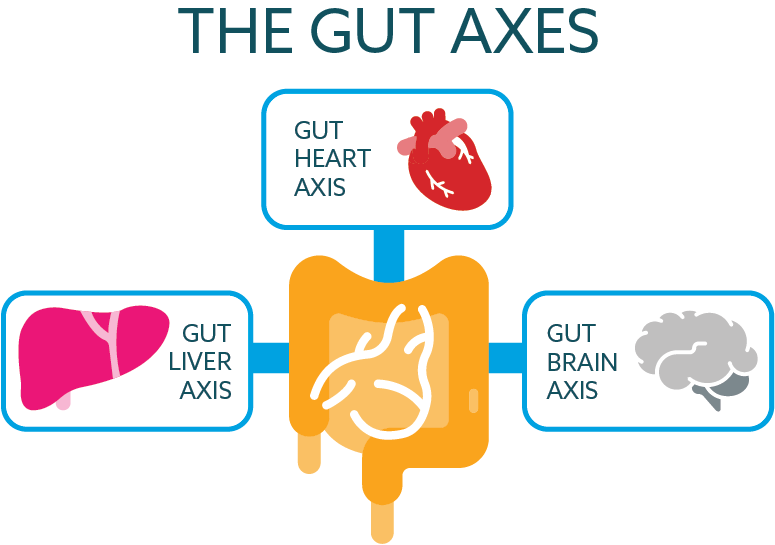The fact that diet influences health is an ancient concept. Nonetheless, as science continues to advance, our understanding of the mechanisms through which it acts has developed and our ability to harness its benefits has progressed and become more focused. Because the effect of diet on health is so widely accepted, its sheer importance is sometimes lost. However, when the influences of diet, the gut microbiome and genetics on the human metabolome were assessed, diet was found to be the strongest influencer by far; influencing 610 compared to 85 and 38 metabolites, respectively1. Such studies remind us of the true importance of using diet as a principal intervention tool for promoting and supporting whole body health.
The gut microbiome
The gut microbiota-host symbiotic relationship exists in such a way that, in exchange for providing a favourable environment for the microbiota, the microbiota work to maintain host health by acting on the gut mucosa and, other organs and body systems. Research in this area has exploded in recent decades with numerous organ and system changes being associated with alterations in the host microbiome. While diet provides the building blocks of the body for growth and regeneration, it also shapes the composition of the gut microbiome. The pathways and mechanisms through which diet and the gut microbiota influence host health are clearer to us in some systems than others. Below are several examples of gut-system axes for which researchers have made significant developments in building our understanding.

The gut-brain axis
The gut-brain axis may be the most widely researched gut-system axis to date. Diet and gut microbial composition are key influencers in the development and degeneration of the brain. The mechanistic pathways include dietary and microbial metabolites, metabolic pathways, gene expression, immune signalling pathways, the vagus nerve, hormonal pathways, and the hypothalamus–pituitary–adrenal axis. Some key dietary influencers of this axis include omega-3 polyunsaturated fatty acids (n-3 PUFA), polyphenols, dietary tryptophan, and emerging food supplements such as turmeric extract (curcumin). These food molecules frequently act through promoting the growth of beneficial gut bacteria, such as Bacillus, Bifidobacteria, Escherichia, Lactobacilli, Enterococcus and Streptococcus genera that can release neuroactive substances such as GABA, serotonin, noradrenaline and acetylcholine2. Other important mechanistic pathways include supporting short chain fatty acid (SCFA) production, in particular butyrate, and anti-inflammatory properties coordinated via the gut microbiota.
The gut-heart axis
Within the gut-heart axis, it has been established that gut microbiome dysbiosis increases cardiovascular risks. Important mechanistic pathways include intestinal permeability, dietary and microbial metabolites, immune pathways, and alterations to the cellular components of the cardiovascular system. Interestingly, polyphenols and n-3 PUFA are also known to promote a healthy cardiovascular system, working, at least partly, via the gut microbiota. More novel dietary elements are also emerging. For example, modified tomato extract, dietary nitrate from plant sources and oat extracts3-5 have been shown to alter gut microbial composition (e.g. promoting Lactobacillus and Bifidobacterium species and reducing Bacteroides and Ruminococcus species) and ultimately act by modifying trimethylamine-n-oxide levels, SCFA, bile salt hydrolase and other critical molecules.
The gut-liver axis
Certain compositions of the gut microbiota have also been linked to multiple liver diseases including chronic hepatitis B and C, alcoholic liver disease, metabolic dysfunction-associated fatty liver disease, non-alcoholic steatohepatitis, liver cirrhosis, and hepatocellular carcinoma. These include increased numbers of Bacteroidetes and Firmicutes phyla, including Ruminococcaceae, Lachnospiraceae, and Clostridiales6. The critical portal circulation along with metabolic, immune, and neuroendocrine systems are the main mechanistic pathways of this gut-liver axis. While a high fat, high sugar diet has been associated with many of the above liver diseases, recent research suggests dietary components such as n-3 PUFA, polyphenols as well as coffee, fermented milk and ginseng7-9 may help to protect against such pathologies.
The gut microbiome and the immune system
Even looking briefly at a few gut-organ axes, it is evident that scientific research has brought to the forefront some important dietary groups and mechanistic pathways. PUFA, complex carbohydrates and dietary components with strong anti-inflammatory and antioxidant properties are repeatedly shown to benefit host health. Immune, hormonal and metabolic pathways have all been shown to be acted upon by the diet-microbiota interactions. Autophagy, the natural destruction of damaged or redundant cellular components within the cell cytoplasm, is thought to regulate intestinal permeability and is another important mechanism of cross-talk between the gut microbiota and host responses. Novel food supplements such as urolithin A, spermidine and nuciferine10-12 have been shown to alter the host gut microbiota and active autophagy, resulting in prevention or reduction of pathologies.
Microbiome research advancements and conclusions
Although exciting developments in this field are continuing, a recent review of studies from around the world concluded that while many studies are demonstrating diet-induced changes in gut microbe abundances and the production of fermentation products, such as SCFA and phytochemicals, they are failing to properly measure the implied health benefits13. How observed changes in microbiota composition and metabolism can improve our health and be used to prevent and treat disease is often still to be fully elucidated. More phased studies that build on robust pre-clinical trials to track the mechanistic pathways of dietary interventions through to vigorously assessed participant outcomes are needed. This should be a primary focus for future studies in the health food sector to help ensure maximum value of products are identified, harnessed, and ultimately shared with the consumer.
As a spin out of the APC Microbiome Ireland, Atlantia Clinical Trials has extensive experience in conducting clinical trials with probiotics, prebiotics and postbiotics in multiple health areas. Have a look at our recent publications and browse our clinical research services to learn more. Alternately, feel free to book your clinical trial consultation with our team to discuss about a specific project.
References
1. Chen, L., Zhernakova, D.V., Kurilshikov, A. et al. Influence of the microbiome, diet and genetics on inter-individual variation in the human plasma metabolome. Nat Med 28, 2333–2343 (2022). https://doi.org/10.1038/s41591-022-02014-8
2. Cohen Kadosh, K., Muhardi, L., Parikh, P., Basso, M., Jan Mohamed, H.J., Prawitasari, T., Samuel, F., Ma, G. and Geurts, J.M., 2021. Nutritional support of neurodevelopment and cognitive function in infants and young children—an update and novel insights. Nutrients, 13(1), p.199.
3. Rehman, A., Tyree, S.M., Fehlbaum, S., DunnGalvin, G., Panagos, C.G., Guy, B., Patel, S., Dinan, T.G., Duttaroy, A.K., Duss, R. and Steinert, R.E., 2023. A water-soluble tomato extract rich in secondary plant metabolites lowers trimethylamine-n-oxide and modulates gut microbiota: a randomized, double-blind, placebo-controlled cross-over study in overweight and obese adults. The Journal of Nutrition, 153(1), pp.96-105.
4. Gee LC, Ahluwalia A. Dietary nitrate lowers blood pressure: epidemiological, pre-clinical experimental and clinical trial evidence. Curr Hypertens Rep. 2016;18(2):17.
5. Duysburgh, C., Van den Abbeele, P., Kamil, A., Fleige, L., De Chavez, P.J., Chu, Y., Barton, W., O’Sullivan, O., Cotter, P.D., Quilter, K. and Joyce, S.A., 2021. In vitro–in vivo validation of stimulatory effect of oat ingredients on lactobacilli. Pathogens, 10(2), p.235.
6. Milosevic, I., Vujovic, A., Barac, A., Djelic, M., Korac, M., Radovanovic Spurnic, A., Gmizic, I., Stevanovic, O., Djordjevic, V., Lekic, N. and Russo, E., 2019. Gut-liver axis, gut microbiota, and its modulation in the management of liver diseases: a review of the literature. International journal of molecular sciences, 20(2), p.395.
7. Vitaglione, P., Mazzone, G., Lembo, V., D'Argenio, G., Rossi, A., Guido, M., Savoia, M., Salomone, F., Mennella, I., De Filippis, F. and Ercolini, D., 2019. Coffee prevents fatty liver disease induced by a high-fat diet by modulating pathways of the gut–liver axis. Journal of nutritional science, 8, p.e15.
8. He, Q., Yang, C., Kang, X., Chen, Y., Zhang, T., Zhang, H. and Kwok, L.Y., 2022. Intake of Bifidobacterium lactis Probio-M8 fermented milk protects against alcoholic liver disease. Journal of Dairy Science, 105(4), pp.2908-2921.
9. Xu Y, Yang C, Zhang S, Li J, Xiao Q, Huang W (2018) Ginsenoside Rg1 protects against nonalcoholic fatty liver disease by ameliorating lipid peroxidation, endoplasmic reticulum stress, and infammasome activation. Biol Pharm Bull 41(11):1638–1644.
10. Singh, A., D’Amico, D., Andreux, P.A., Dunngalvin, G., Kern, T., Blanco-Bose, W., Auwerx, J., Aebischer, P. and Rinsch, C., 2022. Direct supplementation with Urolithin A overcomes limitations of dietary exposure and gut microbiome variability in healthy adults to achieve consistent levels across the population. European journal of clinical nutrition, 76(2), pp.297-308.
11. Ma, L., Ni, Y., Wang, Z., Tu, W., Ni, L., Zhuge, F., Zheng, A., Hu, L., Zhao, Y., Zheng, L. and Fu, Z., 2020. Spermidine improves gut barrier integrity and gut microbiota function in diet-induced obese mice. Gut Microbes, 12(1), p.1832857.
12. Shi, Z., Fang, Z.Y., Gao, X.X., Yu, H., Zhu, Y.W., Ouyang, H.L., Song, Y.X., Du, X.L., Wang, Z., Li, X.W. and Liu, G.W., 2021. Nuciferine improves high-fat diet-induced obesity via reducing intestinal permeability by increasing autophagy and remodeling the gut microbiota. Food & Function, 12(13), pp.5850-5861.
13. Leeming, E.R., Johnson, A.J., Spector, T.D. and Le Roy, C.I., 2019. Effect of diet on the gut microbiota: rethinking intervention duration. Nutrients, 11(12), p.2862.
/Images/649c44339b81d5725fcd94b7_sian-lucking.jpg?width=290&name=649c44339b81d5725fcd94b7_sian-lucking.jpg)

